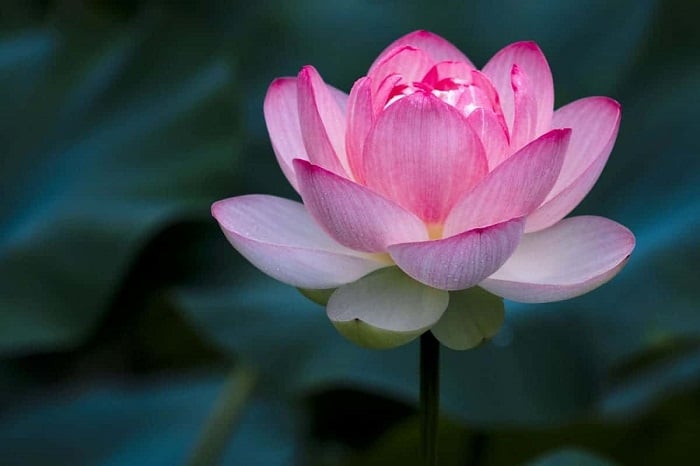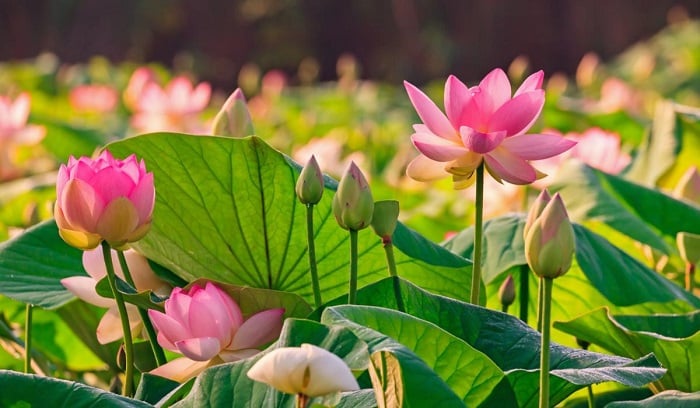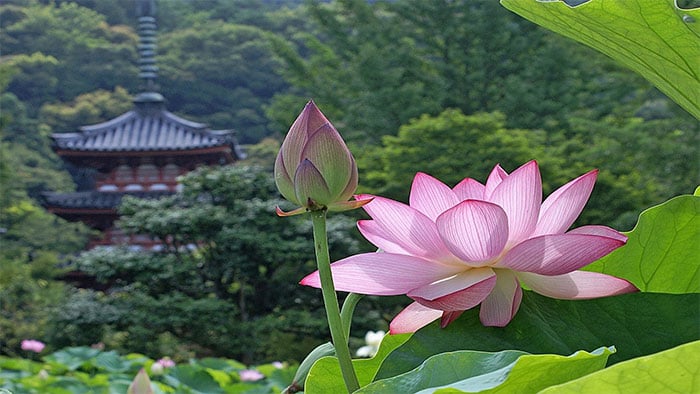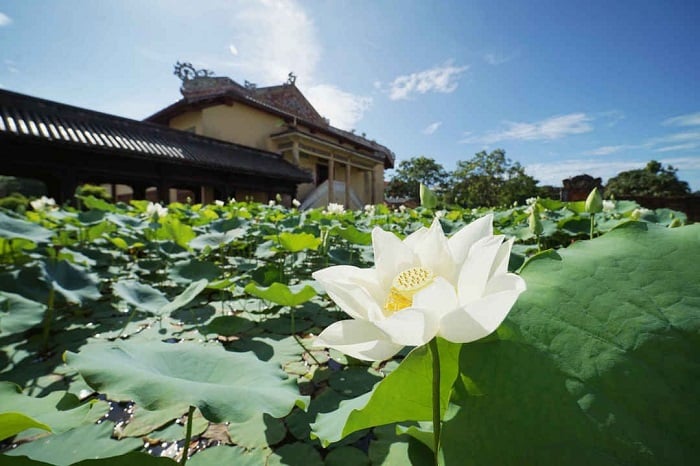
The lotus flower is widely regarded as Vietnam’s national flower, capturing the essence of the country’s culture and its people. Revered for its symbolic representation of purity, elegance, and strength, the lotus holds a special place in the hearts of Vietnamese locals. As you embark on your journey to Vietnam, it is important to understand the significance of this unique national flower.
The lotus is a perennial aquatic plant, with its stem, roots, and petioles submerged beneath the water, while its flower stalk and leaf blade remain above the surface. When the lotus is in full bloom, it unveils multiple layers of petals, resembling boats facing one another.
It is fascinating to note that although the lotus thrives in muddy water, it remains untainted by its surroundings. In fact, the lotus is known to purify the water it grows in, symbolizing the ability to rise above adversity and thrive in even the harshest conditions.
By embracing the symbolism of the lotus, the people of Vietnam exemplify their resilience and beauty, making it a fitting choice for their national flower. As you immerse yourself in Vietnam’s rich culture, take a moment to appreciate the significance of the lotus and the core values it represents. This newfound understanding will undoubtedly enhance your travel experience and deepen your connection with this remarkable country.

In Vietnam, the lotus flower holds great cultural significance and is considered the national flower. It embodies various meanings that reflect the traditions and heritage of the country. The lotus comes in different colors, each representing a different symbol.
The pink lotus, one of the most popular in Vietnam, is closely associated with Buddha and Buddhism. It is also seen as a symbol of the beauty found in simplicity and the strong will to live.
The white lotus represents purity of mind and spirit. It symbolizes the heart of Buddha and signifies the ability to overcome difficulties and obstacles.
The gold lotus is a symbol of achieving enlightenment in Buddhism. It represents the ultimate goal of spiritual awakening.
Blue lotus signifies wisdom and consciousness. It is also a symbol of freedom, peace, and prosperity in Vietnam.
Purple lotus is associated with spirituality and mysticism. It holds a deeper meaning and is often linked to divine experiences.
The red lotus represents emotional attachment and is believed to symbolize love, passion, and compassion in Vietnamese culture.
The lotus flower holds significance beyond its color symbolism. It embodies important cultural meanings in Vietnam. Despite growing in muddy waters, the lotus remains untainted and emits a beautiful fragrance. This characteristic represents the strong willpower of the Vietnamese people, who can overcome any adversity they face in life. The lotus also symbolizes individuals who are free from worldly attachments, such as lust or greed.
In Buddhism, the lotus is known as the flower of Buddha. It represents the philosophy of enlightenment and the cycle of life. The different stages of the lotus flower’s growth, from bud to flower to seed, reflect the interconnectedness of past, present, and future.
Overall, the lotus flower holds deep cultural significance in Vietnam. It represents purity, elegance, and strength, and is intertwined with Buddhist beliefs and the resilience of the Vietnamese people.

In Vietnamese culture, the lotus flower holds deep significance and is considered a symbol of various aspects. Stemming from Buddhism, the lotus is believed to bring peace, luck, and fortune to those who embrace it. As a result, there has been a growing inclination towards lotus paintings, with many individuals choosing to display them in their offices and living spaces.
Beyond its association with luck and blessings, the lotus flower has also come to symbolize purity and love in Vietnamese tradition. It has become a heartfelt expression of affection, representing a desire for genuine love and a harmonious marriage. Bestowing your loved one with the national flower of Vietnam is believed to convey these sentiments and foster a strong bond.
Additionally, the lotus flower holds a special meaning for Vietnamese women. It is seen as a representation of their inherent beauty, encompassing both physical attributes and inner grace. Despite facing life’s challenges, Vietnamese women continue to radiate elegance and display impeccable manners, much like the delicate and resilient nature of the lotus itself.

The national flower of Vietnam is a stunning symbol of beauty and elegance, specifically representing Vietnamese women. If you’re looking to witness the enchanting sight of lotus flowers in full bloom, here are three top-notch locations you should visit:
1. West Lake Lotus Field in Hanoi: As the capital city of Vietnam, Hanoi boasts numerous ponds and lakes where lotus flowers thrive. One of the best places to witness Vietnam’s national flower is the West Lake Lotus Field. For an optimal experience, head here in the morning when the dew still clings to the leaves. Alternatively, the late afternoon offers a delightful fragrance as the lotus blossoms spread their aroma around the lake.
The West Lake Lotus Field is renowned for its vast expanse, impressive lotus buds, and vibrant pink petals. Visitors can relish in the picturesque scenery, breathe in the fresh air, and even enjoy lotus-based treats like tea or jam at the local tea shops. Capture the moment by taking photos with these exquisite flowers, immortalizing the beauty of this cultural symbol.
Remember, the lotus flowers thrive in warm weather, especially during the summer. So plan your visit accordingly and immerse yourself in the serene and captivating ambiance of these blooming national treasures.

Tinh Tam Lotus Field in Hue is a renowned spot to appreciate the enchanting beauty of lotus flowers in Vietnam. When visiting Hue in late May or early June, tourists will be delighted to discover numerous lotus ponds scattered throughout the city. Among them, Tinh Tam Lotus Field stands out as one of the most popular destinations to immerse oneself in the allure of these delicate blossoms. As the first rays of summer sunshine illuminate the field, the lotus flowers burst into vibrant hues, enhancing the tranquility and allure of Hue.
The Tinh Tam Lotus Field captivates visitors with the graceful presence of Vietnam’s national flower, gently swaying in the breeze. Its delicate beauty and soothing fragrance create a serene atmosphere, making one’s fatigue and sorrows vanish. Take a leisurely stroll through the city, capturing the breathtaking moments of this ancient capital, and let the delicate aroma of the national flower of Vietnam whisper a sense of rejuvenation.

The Dong Thap Lotus Field in Vietnam’s Southern region is a must-visit for tourists, especially during the summer months. This picturesque location is known for its stunning display of lotus flowers, which bloom almost all year round but are at their most beautiful from June to September.
When you visit the Dong Thap Lotus Field, you will be greeted by a sea of white lotus blooms in the early morning. As the day progresses, these delicate flowers transform into a beautiful pink shade, and by mid-afternoon, they turn a majestic purple.
The changing colors of the lotus flowers throughout the day make the sight at the Dong Thap Lotus Field incredibly poetic and romantic. It’s no wonder that this place has become renowned as one of the best lotus ponds in Vietnam.
Besides admiring the natural beauty of the lotus, visitors to the Dong Thap Lotus Field can also enjoy a range of exciting activities. You can take a boat ride on the serene waters, try your hand at fishing, or even join the locals in picking the lotus flowers.
A visit to the Dong Thap Lotus Field promises an enchanting and unique experience, allowing you to immerse yourself in the beauty of Vietnam’s national flower while partaking in exciting activities.

The Dong Thap Lotus Field is a must-visit destination in Vietnam, where visitors can marvel at the breathtaking beauty of the country’s national flower. Unlike other flowers that bloom only during specific seasons, the lotus can be found in full bloom all year round at this enchanting location.
The significance of the lotus in Vietnamese culture is undeniable. It plays a central role in various traditional cultural activities and is prominently featured in festivals and events throughout the country. Its symbolic presence can also be observed in intricate artworks, textiles, and architectural designs, which showcase the profound influence of the lotus on Vietnamese artistic expression.
The lotus serves as a muse for artists, inviting contemplation and evoking deep emotions. In the realm of literature, poets are inspired by the beauty and resilience of the lotus, often penning verses that capture its essence. Songs dedicated to the lotus celebrate its elegance and its profound symbolism, thus further emphasizing its importance in Vietnamese culture.
From paintings to sculptures, the lotus remains a timeless symbol that is woven into the fabric of Vietnamese heritage. Its enduring presence in various forms of art is a testament to its significance and the admiration it commands among the Vietnamese people. A trip to the Dong Thap Lotus Field offers visitors a unique opportunity to immerse themselves in the cultural richness and beauty that surrounds the lotus flower in Vietnam.
_1689071828.jpg)
The rich tapestry of Vietnamese culture is intricately woven with the symbolism and significance of the lotus flower.
_1689071887.jpg)
Vietnamese cuisine has a distinct and unique flavor, thanks in part to the incorporation of the lotus flower in many traditional dishes. The delicate and subtle taste of the lotus adds a touch of elegance to Vietnamese cuisine.
In Vietnamese culture, the different parts of the lotus flower are used in various culinary creations. The lotus stems are used in salads, adding a crisp and refreshing element. The stamens of the lotus are dried and brewed into herbal tea, providing a soothing and aromatic beverage. Lotus seeds, known for their nutritional value, are enjoyed in raw, dried, or boiled forms and are often used in desserts and sweet soups.
One notable use of lotus in Vietnamese cuisine is in mooncakes with lotus seed paste. These sweet treats are a popular delicacy during festivals and celebrations. Additionally, lotus leaves are used as natural wrappers for dishes like steamed rice, infusing them with a unique and pleasant aroma.
The inclusion of lotus in Vietnamese cuisine demonstrates the creativity and innovation of Vietnamese culinary traditions. It not only adds flavor but also enhances the visual appeal of dishes, making them even more enticing to the palate. So, when exploring Vietnamese cuisine, be sure to savor the delicate taste and elegant touch that the lotus flower brings to the table.
_1689071934.jpg)
The use of lotus in Vietnamese cuisine highlights its nutritional benefits (Source: Collected). After enjoying the picturesque lotus ponds in Vietnam and participating in the mentioned activities, you can enhance your trip by exploring other destinations like Phu Quoc, Nha Trang, Hoi An, Da Nang, and more. To make the most of your stay in each of these Vietnam destinations, it’s advisable to plan ahead and choose the ideal accommodation. Consider booking a room at one of the prestigious Vinpearl hotel and resort complexes. Strategically situated in prime locations, Vinpearl offers visitors luxurious rooms, exceptional services, and a plethora of enticing amenities including restaurants, bars, swimming pools, entertainment areas, and more. Vinpearl has a presence in most major cities across Vietnam.

Indulging in the delightful ease of a Vinpearl getaway
Vietnam boasts the majestic lotus, a revered symbol embodying purity and holding significant value in the hearts of its people. This piece endeavors to enlighten you about the enchanting lotus, unveiling the opportune moments and locations to witness its enchanting blossoms in Vietnam’s captivating landscapes.




